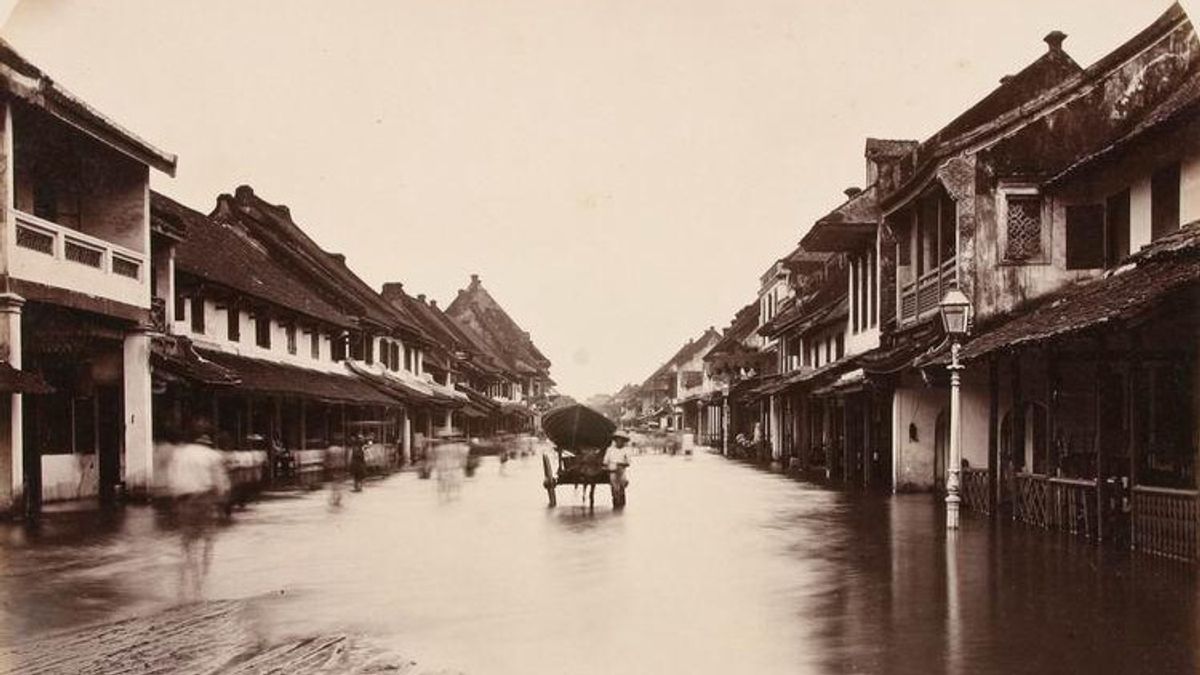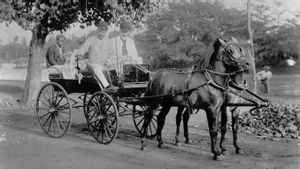JAKARTA - Jakarta floods are a curse. The pessimists will say so. However, it is not entirely wrong to see the long history of flooding in the capital. Since Batavia, from the reign of the Governor-General of the VOC Jan Pieterszoon Coen, this region has had the same problems. One important figure in the flood management efforts in Batavia was Herman van Breen.
Indeed, floods never really go away. But a significant effort was made to register Van Breen's name as an important actor in the effort to drive water away. At one point, the Jakarta floods had been overcome. At that time, Van Breen built a dam to a canal.
The history of Batavia flood management began when the capital city was hit by a big flood in 1873. This flood made the Dutch colonial government confused. As an idea to fight floods, the government started pioneering the Burgerlijke Openbare Werken (BOW) aka Public Works Bureau (PU).
However, the massive prevention of flooding in Jakarta began in the era of MH Thamrin, who was active as a member of the Batavia City Council. Thamrin, now known as Indonesia's national hero, invited a man named Herman van Breen. Both of them then pioneered strategies and efforts to prevent floods in 1919.
"When there was a flood that submerged almost the entire city of Batavia in 1873, this agency (BOW) was misrepresented as Batavia Onder Water (Batavia under water). After the flood again submerged Batavia in 1918 and claimed a number of victims, the Dutch colonial government began planning efforts to control the flood and appointed Prof. Dr. Herman van Breen as Chairman of the Flood Prevention Planning Team. At that time, the area of Batavia City was still 2,500 hectares, ”said Adhi Kusumaputra in the East Flood Canal: Karya Anak Bangsa (2010).

Van Breen who was born in Amsterdam May 28, 1881 is a civil engineer who graduated from the Polytechnische School Delft. His first career was working at Burgerlijke Openbare Werken (BOW) aka the Dutch Public Works (PU) bureau.
Van Breen got his first assignment to work in Jember, the Dutch East Indies. It was there that Van Breen's career as an engineer in the Dutch East Indies began. Along with his persistence, Van Breen's career continued to climb. In 1911 Van Breen became Head of the Batavia Irrigation Office. Afterwards, Van Breen became the Batavia Flood Prevention Planning Team.
"With the direct interest of the Dutch in urban life, they prioritize city development in the form of providing urban infrastructure and facilities. At that time Jakarta city infrastructure and facilities were planned for a population of between 600,000 and 800,000. Among the coaching are, for example, efforts to free Jakarta from floods in which Prof. Ir. Van Breen developed the concept of canal flood control to control the flow of the Ciliwung River, "wrote former Jakarta Governor Ali Sadikin in the book Gita Jaya (1977).
Van Breen's Efforts to Cope with Jakarta FloodsVan Breen was assigned by the Dutch colonial government to control the flow of water from the upstream of the river and limit the volume of water entering the city. Van Breen was chosen because he is known as an expert in his field. Van Breen is even mentioned as an engineer who can think beyond the times. In his concept, Van Breen built a final catchment channel on the southern edge of the city to accommodate runoff water. This overflow of water then flows into the sea through the western edge of the city.
The collecting channel is known as the West Flood Canal (BKB) which was built in 1922. BKB stretches across Batavia, from the Manggarai Water Gate and ends in the Muara Angke area. BKB is quite potent. The river load to the north of the channel appears to be more controlled. BKB is also an important part of the city macro drainage system which functions to reduce standing water in the city.
[/ read_more]

Regarding the location of the Manggarai floodgate, Van Breen has its own reasons. Manggarai, said Van Breen, is believed to be the starting point of the canal. Van Breen argued that Manggarai was the southern boundary of the city, which at that time was still relatively flood free. This facilitates the water flow control system during the rainy season, such as regulating water discharge into the city, for example.
There are also other advantages of the Manggarai Sluice Gate, namely to regulate the discharge of Ciliwung Lama River, Karet, Krukut Lama River, and Cideng Bawah River. Not only that. BKB also controls floods from Menteng and Weltevreden (the area around Lapangan Banteng). Due to the success of Van Breen, the road on the banks of the flood canal took its name, Van Breen Weg (Now: Jalan Latuharhari).
Dutch are stingy and deforestationVan Breen's efforts were successful. Honey, it didn't last long. The root of the problem was that Batavia was expanding and the population of the city was increasing. In addition, the Dutch colonial government did not immediately follow up on Van Breen's plan.
The government seems quite satisfied with the canal flooding. It is not uncommon for the government to deify flood canals as the only reason that the floods will not greet Batavia again. Van Breen knew this was a mistake.
Flood canals, according to Van Breen, cannot be the only option for flood control. There must be other efforts. Historian JJ Rizal said the slow and stingy Dutch steps were the source of the problem. In fact, Van Breen had previously asked the colonial government to pay serious attention to the role of non-infrastructure elements in overcoming floods.
[/ read_more]

"In 1923, in an review of the flood problem, Van Breen revealed that there must be a set of non-infrastructure rules in order for flood infrastructure work to proceed, namely maintaining the profile of all rivers, stopping deforestation and reforestation in southern Batavia, maintaining infiltration and storage of artificial and natural water - reservoirs. and there — because the water problem in Batavia is not related to excess water in the rainy season, but also a shortage in the summer, ”JJ Rizal wrote in Tempo Magazine entitled Thousands of Years of Floods in Jakarta (2013).
JJ Rizal also added two causes of flood canal failure. First, the colonial government tended to be stingy. JJ Rizal likens the colonial government to being a stingy grocer. As a result, Van Breen's plans were piecemeal.
Second, the increasingly massive deforestation in the mountainous area of central northern West Java. The denudation has been mostly done to open up tea plantations since 1877.
"During the first fifty years, flood management became the main priority in the first ten years, namely the period 1911-1919. After that there was a decrease in flood management. However, the results obtained during this period have been used as the basis for further development. Even Herman van Breen's thoughts became the master plan for the next flood management, "Restu Gunawan in the book Failure of the Canal System (2010).
MEMORY Other[/ read_more]
The English, Chinese, Japanese, Arabic, and French versions are automatically generated by the AI. So there may still be inaccuracies in translating, please always see Indonesian as our main language. (system supported by DigitalSiber.id)









